WEL201A Case Study: Managing the Needs of Diverse Aboriginal Groups
VerifiedAdded on 2023/06/08
|12
|3850
|359
Case Study
AI Summary
This case study investigates the challenges faced by Aboriginal and Torres Strait Islander communities in accessing healthcare and other essential services in Australia. It highlights the social, economic, and political issues contributing to these disparities, including lack of access to services, inadequate healthcare, limited education, high unemployment, and ineffective governmental programs. The study also emphasizes the importance of cultural competency in providing effective care, suggesting strategies for healthcare providers to build trust, reduce cultural differences, and respect the beliefs of Indigenous communities. Furthermore, it outlines various health and community services available to Aboriginal and Torres Strait Islander people, highlighting the need for continued efforts to address systemic inequalities and improve the well-being of these vulnerable populations. The National Aboriginal Community Controlled Health Organisations (NACCHO) plays a vital role in advising the government on health policies and budget allocations for this community.

Managing the Needs of
Diverse Client Groups
Diverse Client Groups
Paraphrase This Document
Need a fresh take? Get an instant paraphrase of this document with our AI Paraphraser

Contents
INTRODUCTION...........................................................................................................................1
BRIEF REVIEW..............................................................................................................................1
INVESTIGATION...........................................................................................................................1
DISCUSSION .................................................................................................................................3
CONCLUSION ...............................................................................................................................5
REFERENCES................................................................................................................................5
INTRODUCTION...........................................................................................................................1
BRIEF REVIEW..............................................................................................................................1
INVESTIGATION...........................................................................................................................1
DISCUSSION .................................................................................................................................3
CONCLUSION ...............................................................................................................................5
REFERENCES................................................................................................................................5

INTRODUCTION
Aboriginals and Torres Strait Islander are the community groups who maintain strong
connections to their tradition, culture, language, and religious beliefs. The vulnerable groups
found to struggling their existence in Australia. Community does not have any proper access to
medical, and general services. This was the main reason behind reduced average of life
expectancy among the group (Bourke and et. al., 2021). In comparison to non-indigenous people,
24.4 percent of Aboriginal and Torres Strait Islander people were not employed in 2012-2013.
Females of vulnerable community experience physical violence as well they were more likely to
experience harassment, and rape practices. Barriers to access medical services and improper
knowledge due to absence of academic studies within the group caused them to face long-term
health conditions or some form of disability in 2008. Improper access to medical facilities,
unhealthy way of life leads them to develop and face many psychological distress which impact
their physical, social, and mental well-being.
BRIEF REVIEW
In this report, the case study will cover and investigate the barriers faced by Aboriginal
ans Torres Strait Australian group in accessing care and medical services. Discussion will cover
the existing opportunities to be supported through the community. It enhance the knowledge
about the considerations one need to follow and keep in mind while dealing and providing
services to the community. Many governmental and non-governmental agencies took steps to
introduce the indigenous community to development and provide them access to many services
(Browne and et. al., 2019).
INVESTIGATION
In Australia, Aboriginal community and Torres Strait Islander people are more exposed
than non- indigenous people to experience many social issues, including exposure to violence,
higher unemployment rates, alcohol and substance abuse, trauma, legal injustice, isolation,
poverty, and discrimination. Communities are experiencing serious issues that impact their
development, mental and physical health. Some relevant consequences are:
Lack of services: Communities have no access to disability and medical services and
also experience lack of community health care centres within location.
1
Aboriginals and Torres Strait Islander are the community groups who maintain strong
connections to their tradition, culture, language, and religious beliefs. The vulnerable groups
found to struggling their existence in Australia. Community does not have any proper access to
medical, and general services. This was the main reason behind reduced average of life
expectancy among the group (Bourke and et. al., 2021). In comparison to non-indigenous people,
24.4 percent of Aboriginal and Torres Strait Islander people were not employed in 2012-2013.
Females of vulnerable community experience physical violence as well they were more likely to
experience harassment, and rape practices. Barriers to access medical services and improper
knowledge due to absence of academic studies within the group caused them to face long-term
health conditions or some form of disability in 2008. Improper access to medical facilities,
unhealthy way of life leads them to develop and face many psychological distress which impact
their physical, social, and mental well-being.
BRIEF REVIEW
In this report, the case study will cover and investigate the barriers faced by Aboriginal
ans Torres Strait Australian group in accessing care and medical services. Discussion will cover
the existing opportunities to be supported through the community. It enhance the knowledge
about the considerations one need to follow and keep in mind while dealing and providing
services to the community. Many governmental and non-governmental agencies took steps to
introduce the indigenous community to development and provide them access to many services
(Browne and et. al., 2019).
INVESTIGATION
In Australia, Aboriginal community and Torres Strait Islander people are more exposed
than non- indigenous people to experience many social issues, including exposure to violence,
higher unemployment rates, alcohol and substance abuse, trauma, legal injustice, isolation,
poverty, and discrimination. Communities are experiencing serious issues that impact their
development, mental and physical health. Some relevant consequences are:
Lack of services: Communities have no access to disability and medical services and
also experience lack of community health care centres within location.
1
⊘ This is a preview!⊘
Do you want full access?
Subscribe today to unlock all pages.

Trusted by 1+ million students worldwide
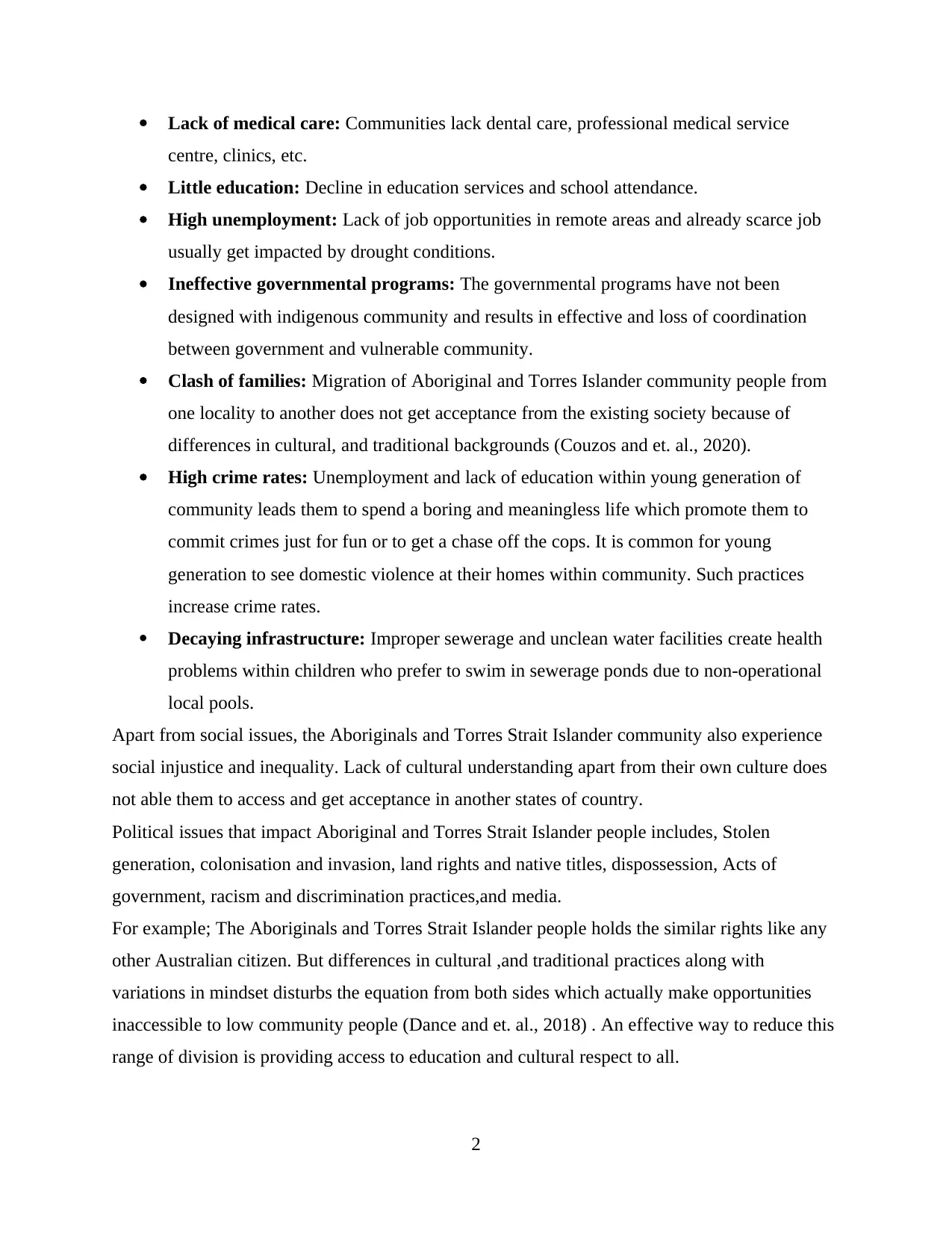
Lack of medical care: Communities lack dental care, professional medical service
centre, clinics, etc.
Little education: Decline in education services and school attendance.
High unemployment: Lack of job opportunities in remote areas and already scarce job
usually get impacted by drought conditions.
Ineffective governmental programs: The governmental programs have not been
designed with indigenous community and results in effective and loss of coordination
between government and vulnerable community.
Clash of families: Migration of Aboriginal and Torres Islander community people from
one locality to another does not get acceptance from the existing society because of
differences in cultural, and traditional backgrounds (Couzos and et. al., 2020).
High crime rates: Unemployment and lack of education within young generation of
community leads them to spend a boring and meaningless life which promote them to
commit crimes just for fun or to get a chase off the cops. It is common for young
generation to see domestic violence at their homes within community. Such practices
increase crime rates.
Decaying infrastructure: Improper sewerage and unclean water facilities create health
problems within children who prefer to swim in sewerage ponds due to non-operational
local pools.
Apart from social issues, the Aboriginals and Torres Strait Islander community also experience
social injustice and inequality. Lack of cultural understanding apart from their own culture does
not able them to access and get acceptance in another states of country.
Political issues that impact Aboriginal and Torres Strait Islander people includes, Stolen
generation, colonisation and invasion, land rights and native titles, dispossession, Acts of
government, racism and discrimination practices,and media.
For example; The Aboriginals and Torres Strait Islander people holds the similar rights like any
other Australian citizen. But differences in cultural ,and traditional practices along with
variations in mindset disturbs the equation from both sides which actually make opportunities
inaccessible to low community people (Dance and et. al., 2018) . An effective way to reduce this
range of division is providing access to education and cultural respect to all.
2
centre, clinics, etc.
Little education: Decline in education services and school attendance.
High unemployment: Lack of job opportunities in remote areas and already scarce job
usually get impacted by drought conditions.
Ineffective governmental programs: The governmental programs have not been
designed with indigenous community and results in effective and loss of coordination
between government and vulnerable community.
Clash of families: Migration of Aboriginal and Torres Islander community people from
one locality to another does not get acceptance from the existing society because of
differences in cultural, and traditional backgrounds (Couzos and et. al., 2020).
High crime rates: Unemployment and lack of education within young generation of
community leads them to spend a boring and meaningless life which promote them to
commit crimes just for fun or to get a chase off the cops. It is common for young
generation to see domestic violence at their homes within community. Such practices
increase crime rates.
Decaying infrastructure: Improper sewerage and unclean water facilities create health
problems within children who prefer to swim in sewerage ponds due to non-operational
local pools.
Apart from social issues, the Aboriginals and Torres Strait Islander community also experience
social injustice and inequality. Lack of cultural understanding apart from their own culture does
not able them to access and get acceptance in another states of country.
Political issues that impact Aboriginal and Torres Strait Islander people includes, Stolen
generation, colonisation and invasion, land rights and native titles, dispossession, Acts of
government, racism and discrimination practices,and media.
For example; The Aboriginals and Torres Strait Islander people holds the similar rights like any
other Australian citizen. But differences in cultural ,and traditional practices along with
variations in mindset disturbs the equation from both sides which actually make opportunities
inaccessible to low community people (Dance and et. al., 2018) . An effective way to reduce this
range of division is providing access to education and cultural respect to all.
2
Paraphrase This Document
Need a fresh take? Get an instant paraphrase of this document with our AI Paraphraser
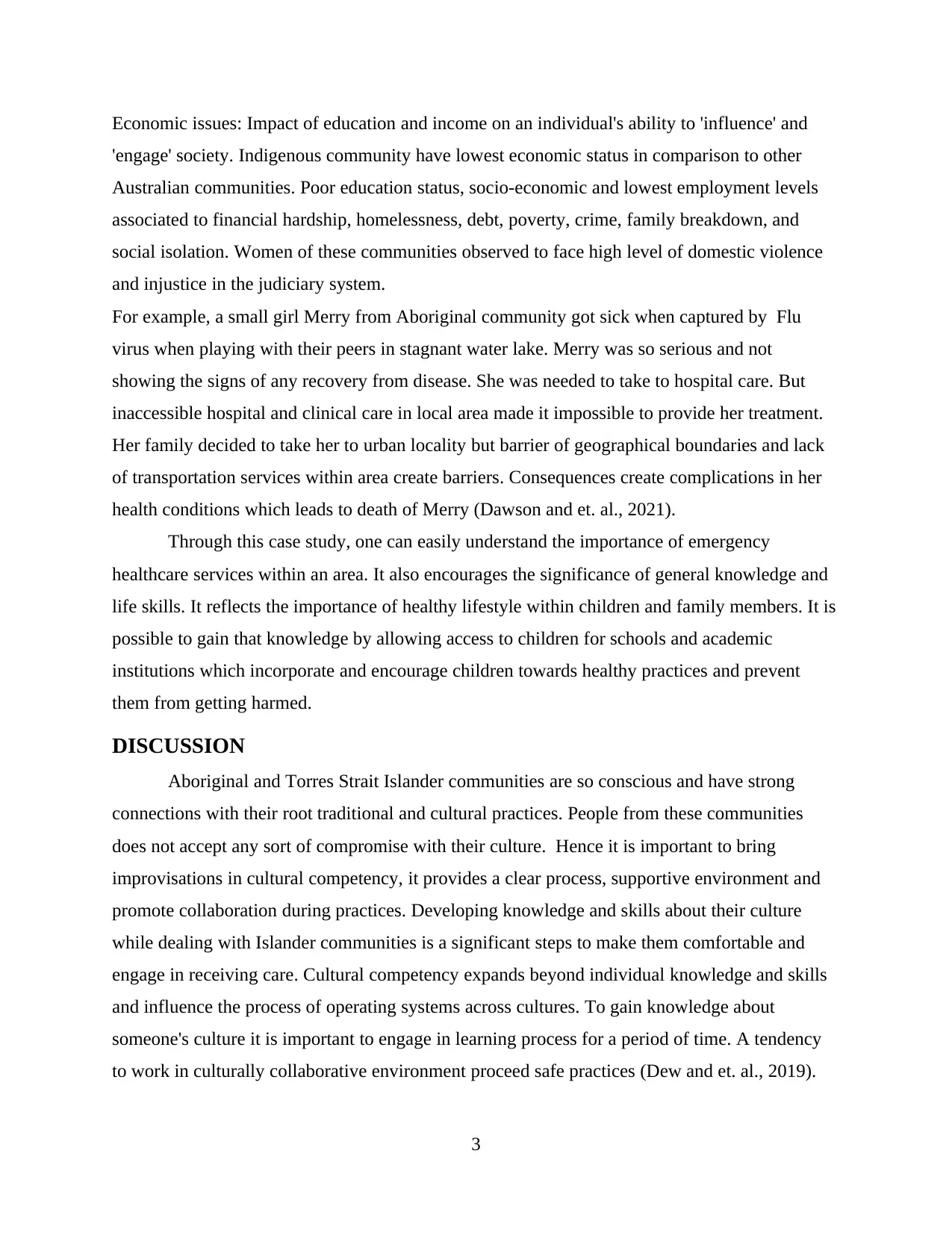
Economic issues: Impact of education and income on an individual's ability to 'influence' and
'engage' society. Indigenous community have lowest economic status in comparison to other
Australian communities. Poor education status, socio-economic and lowest employment levels
associated to financial hardship, homelessness, debt, poverty, crime, family breakdown, and
social isolation. Women of these communities observed to face high level of domestic violence
and injustice in the judiciary system.
For example, a small girl Merry from Aboriginal community got sick when captured by Flu
virus when playing with their peers in stagnant water lake. Merry was so serious and not
showing the signs of any recovery from disease. She was needed to take to hospital care. But
inaccessible hospital and clinical care in local area made it impossible to provide her treatment.
Her family decided to take her to urban locality but barrier of geographical boundaries and lack
of transportation services within area create barriers. Consequences create complications in her
health conditions which leads to death of Merry (Dawson and et. al., 2021).
Through this case study, one can easily understand the importance of emergency
healthcare services within an area. It also encourages the significance of general knowledge and
life skills. It reflects the importance of healthy lifestyle within children and family members. It is
possible to gain that knowledge by allowing access to children for schools and academic
institutions which incorporate and encourage children towards healthy practices and prevent
them from getting harmed.
DISCUSSION
Aboriginal and Torres Strait Islander communities are so conscious and have strong
connections with their root traditional and cultural practices. People from these communities
does not accept any sort of compromise with their culture. Hence it is important to bring
improvisations in cultural competency, it provides a clear process, supportive environment and
promote collaboration during practices. Developing knowledge and skills about their culture
while dealing with Islander communities is a significant steps to make them comfortable and
engage in receiving care. Cultural competency expands beyond individual knowledge and skills
and influence the process of operating systems across cultures. To gain knowledge about
someone's culture it is important to engage in learning process for a period of time. A tendency
to work in culturally collaborative environment proceed safe practices (Dew and et. al., 2019).
3
'engage' society. Indigenous community have lowest economic status in comparison to other
Australian communities. Poor education status, socio-economic and lowest employment levels
associated to financial hardship, homelessness, debt, poverty, crime, family breakdown, and
social isolation. Women of these communities observed to face high level of domestic violence
and injustice in the judiciary system.
For example, a small girl Merry from Aboriginal community got sick when captured by Flu
virus when playing with their peers in stagnant water lake. Merry was so serious and not
showing the signs of any recovery from disease. She was needed to take to hospital care. But
inaccessible hospital and clinical care in local area made it impossible to provide her treatment.
Her family decided to take her to urban locality but barrier of geographical boundaries and lack
of transportation services within area create barriers. Consequences create complications in her
health conditions which leads to death of Merry (Dawson and et. al., 2021).
Through this case study, one can easily understand the importance of emergency
healthcare services within an area. It also encourages the significance of general knowledge and
life skills. It reflects the importance of healthy lifestyle within children and family members. It is
possible to gain that knowledge by allowing access to children for schools and academic
institutions which incorporate and encourage children towards healthy practices and prevent
them from getting harmed.
DISCUSSION
Aboriginal and Torres Strait Islander communities are so conscious and have strong
connections with their root traditional and cultural practices. People from these communities
does not accept any sort of compromise with their culture. Hence it is important to bring
improvisations in cultural competency, it provides a clear process, supportive environment and
promote collaboration during practices. Developing knowledge and skills about their culture
while dealing with Islander communities is a significant steps to make them comfortable and
engage in receiving care. Cultural competency expands beyond individual knowledge and skills
and influence the process of operating systems across cultures. To gain knowledge about
someone's culture it is important to engage in learning process for a period of time. A tendency
to work in culturally collaborative environment proceed safe practices (Dew and et. al., 2019).
3
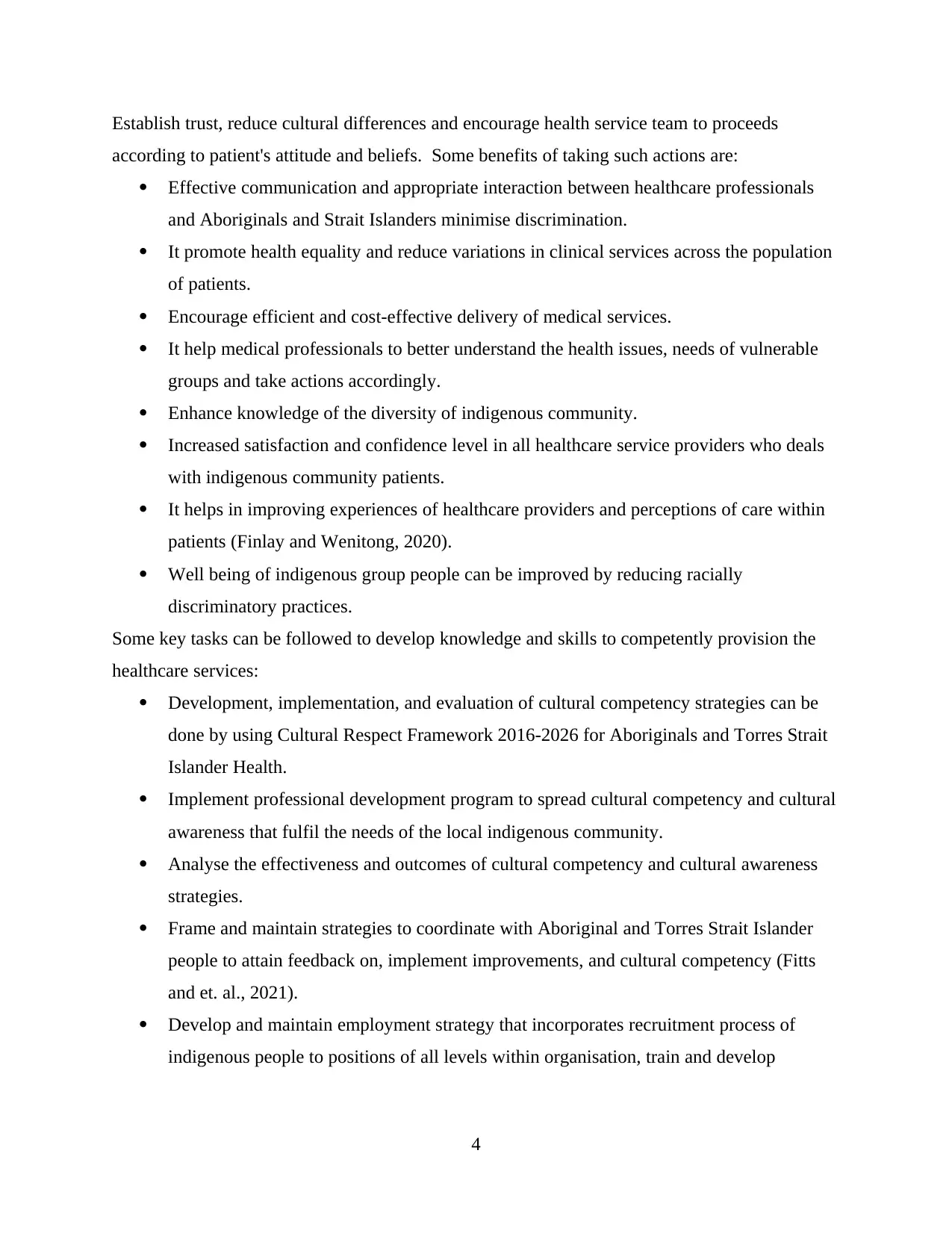
Establish trust, reduce cultural differences and encourage health service team to proceeds
according to patient's attitude and beliefs. Some benefits of taking such actions are:
Effective communication and appropriate interaction between healthcare professionals
and Aboriginals and Strait Islanders minimise discrimination.
It promote health equality and reduce variations in clinical services across the population
of patients.
Encourage efficient and cost-effective delivery of medical services.
It help medical professionals to better understand the health issues, needs of vulnerable
groups and take actions accordingly.
Enhance knowledge of the diversity of indigenous community.
Increased satisfaction and confidence level in all healthcare service providers who deals
with indigenous community patients.
It helps in improving experiences of healthcare providers and perceptions of care within
patients (Finlay and Wenitong, 2020).
Well being of indigenous group people can be improved by reducing racially
discriminatory practices.
Some key tasks can be followed to develop knowledge and skills to competently provision the
healthcare services:
Development, implementation, and evaluation of cultural competency strategies can be
done by using Cultural Respect Framework 2016-2026 for Aboriginals and Torres Strait
Islander Health.
Implement professional development program to spread cultural competency and cultural
awareness that fulfil the needs of the local indigenous community.
Analyse the effectiveness and outcomes of cultural competency and cultural awareness
strategies.
Frame and maintain strategies to coordinate with Aboriginal and Torres Strait Islander
people to attain feedback on, implement improvements, and cultural competency (Fitts
and et. al., 2021).
Develop and maintain employment strategy that incorporates recruitment process of
indigenous people to positions of all levels within organisation, train and develop
4
according to patient's attitude and beliefs. Some benefits of taking such actions are:
Effective communication and appropriate interaction between healthcare professionals
and Aboriginals and Strait Islanders minimise discrimination.
It promote health equality and reduce variations in clinical services across the population
of patients.
Encourage efficient and cost-effective delivery of medical services.
It help medical professionals to better understand the health issues, needs of vulnerable
groups and take actions accordingly.
Enhance knowledge of the diversity of indigenous community.
Increased satisfaction and confidence level in all healthcare service providers who deals
with indigenous community patients.
It helps in improving experiences of healthcare providers and perceptions of care within
patients (Finlay and Wenitong, 2020).
Well being of indigenous group people can be improved by reducing racially
discriminatory practices.
Some key tasks can be followed to develop knowledge and skills to competently provision the
healthcare services:
Development, implementation, and evaluation of cultural competency strategies can be
done by using Cultural Respect Framework 2016-2026 for Aboriginals and Torres Strait
Islander Health.
Implement professional development program to spread cultural competency and cultural
awareness that fulfil the needs of the local indigenous community.
Analyse the effectiveness and outcomes of cultural competency and cultural awareness
strategies.
Frame and maintain strategies to coordinate with Aboriginal and Torres Strait Islander
people to attain feedback on, implement improvements, and cultural competency (Fitts
and et. al., 2021).
Develop and maintain employment strategy that incorporates recruitment process of
indigenous people to positions of all levels within organisation, train and develop
4
⊘ This is a preview!⊘
Do you want full access?
Subscribe today to unlock all pages.

Trusted by 1+ million students worldwide

professional development processes, increase employment opportunities by establishing
development pathways.
In order to improve safe cultural practices; use continuos quality improvement methods
and incorporate them within health service organisations.
For example, A child from Torres Strait Islander group got sick and need emergency help to
control the situation. Health services were not available in local areas make them decide to get
the patient in urban areas to avail medical facilities but improper transportation facility made it
impossible for them . So they decided to call helpline no. and requested health team to approach
to remote area as soon as possible. Health team reach there and try to provide effective treatment
to the patient. But treatment provided by healthcare team was rendered by Local people as it was
involving an activity which was culturally unaccepted by the society (Hickey and et. al., 2019).
So healthcare providers interact with them and try to understand their beliefs regarding the
practice. Hence healthcare professionals decided to choose an alternate option to treat the child
and does not infringe their cultural belief instead paid respect to their culture and try to control
the situation by adopting an alternate way.
Various health and community services, programs , and concessions are available for Aboriginal
and Torres Strait Islander people includes;
COVID-19 Aboriginal health resources: the service includes information regarding
testing, vaccination, culture and well-being available on NSW health.
Wurruwi Gambling Help: facilitate counselling services for indigenous people
struggling with gambling problems.
Aboriginal Health and Medical Research Council: provide access to Aboriginal
Community Controlled Health Services (ACCHS) members who investigate and opearte
in local communities.
First People Disability Network (FPDN): this network provide support to Australia's
first peoples who suffer with issue of disability.
Aboriginal Family, Child, and Community Care State secretariat: Provide support to
protect children and a policy named out-of-home care give advice regarding Aboriginal
children, families, young people, and carers (Pearson and et. al., 2020).
5
development pathways.
In order to improve safe cultural practices; use continuos quality improvement methods
and incorporate them within health service organisations.
For example, A child from Torres Strait Islander group got sick and need emergency help to
control the situation. Health services were not available in local areas make them decide to get
the patient in urban areas to avail medical facilities but improper transportation facility made it
impossible for them . So they decided to call helpline no. and requested health team to approach
to remote area as soon as possible. Health team reach there and try to provide effective treatment
to the patient. But treatment provided by healthcare team was rendered by Local people as it was
involving an activity which was culturally unaccepted by the society (Hickey and et. al., 2019).
So healthcare providers interact with them and try to understand their beliefs regarding the
practice. Hence healthcare professionals decided to choose an alternate option to treat the child
and does not infringe their cultural belief instead paid respect to their culture and try to control
the situation by adopting an alternate way.
Various health and community services, programs , and concessions are available for Aboriginal
and Torres Strait Islander people includes;
COVID-19 Aboriginal health resources: the service includes information regarding
testing, vaccination, culture and well-being available on NSW health.
Wurruwi Gambling Help: facilitate counselling services for indigenous people
struggling with gambling problems.
Aboriginal Health and Medical Research Council: provide access to Aboriginal
Community Controlled Health Services (ACCHS) members who investigate and opearte
in local communities.
First People Disability Network (FPDN): this network provide support to Australia's
first peoples who suffer with issue of disability.
Aboriginal Family, Child, and Community Care State secretariat: Provide support to
protect children and a policy named out-of-home care give advice regarding Aboriginal
children, families, young people, and carers (Pearson and et. al., 2020).
5
Paraphrase This Document
Need a fresh take? Get an instant paraphrase of this document with our AI Paraphraser
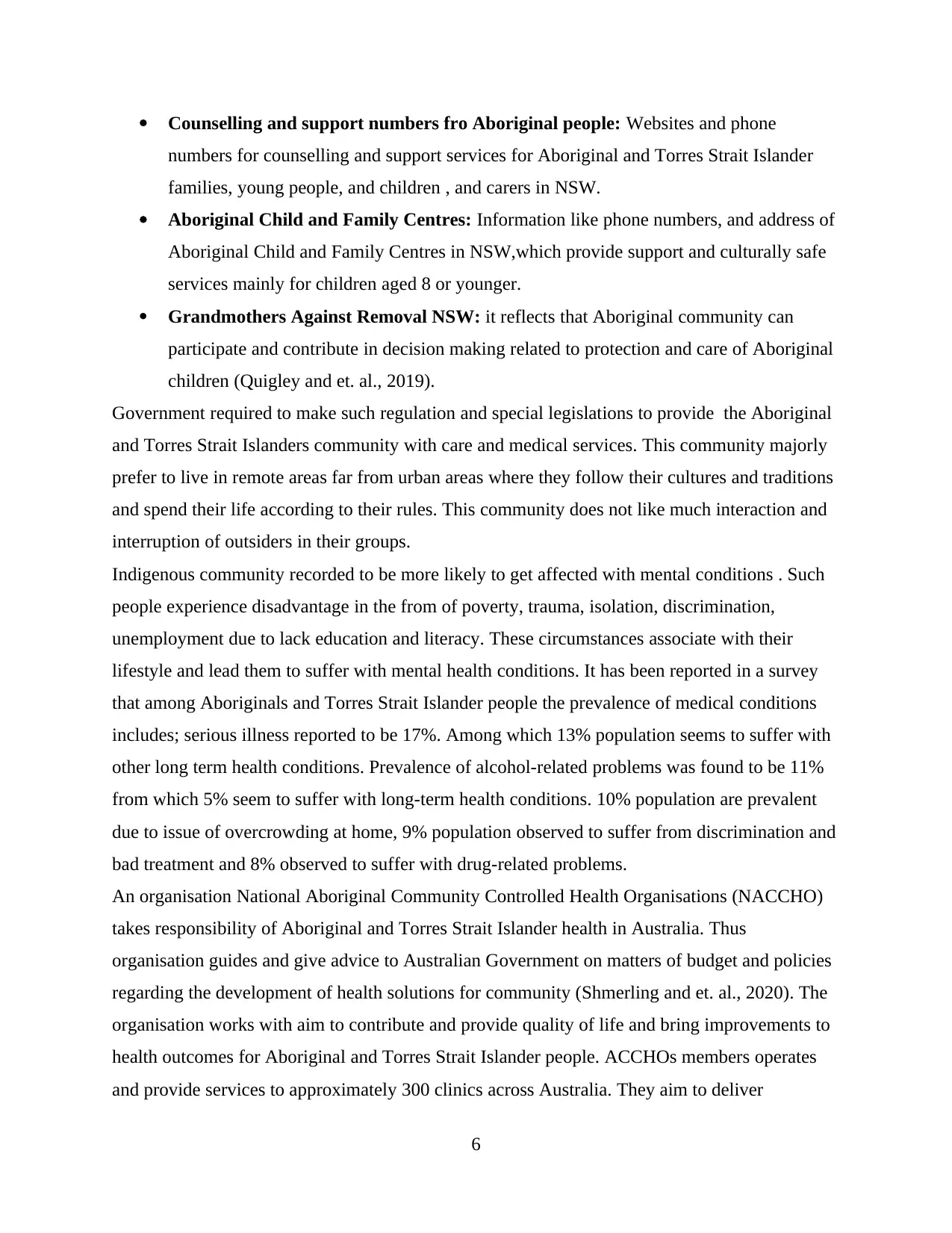
Counselling and support numbers fro Aboriginal people: Websites and phone
numbers for counselling and support services for Aboriginal and Torres Strait Islander
families, young people, and children , and carers in NSW.
Aboriginal Child and Family Centres: Information like phone numbers, and address of
Aboriginal Child and Family Centres in NSW,which provide support and culturally safe
services mainly for children aged 8 or younger.
Grandmothers Against Removal NSW: it reflects that Aboriginal community can
participate and contribute in decision making related to protection and care of Aboriginal
children (Quigley and et. al., 2019).
Government required to make such regulation and special legislations to provide the Aboriginal
and Torres Strait Islanders community with care and medical services. This community majorly
prefer to live in remote areas far from urban areas where they follow their cultures and traditions
and spend their life according to their rules. This community does not like much interaction and
interruption of outsiders in their groups.
Indigenous community recorded to be more likely to get affected with mental conditions . Such
people experience disadvantage in the from of poverty, trauma, isolation, discrimination,
unemployment due to lack education and literacy. These circumstances associate with their
lifestyle and lead them to suffer with mental health conditions. It has been reported in a survey
that among Aboriginals and Torres Strait Islander people the prevalence of medical conditions
includes; serious illness reported to be 17%. Among which 13% population seems to suffer with
other long term health conditions. Prevalence of alcohol-related problems was found to be 11%
from which 5% seem to suffer with long-term health conditions. 10% population are prevalent
due to issue of overcrowding at home, 9% population observed to suffer from discrimination and
bad treatment and 8% observed to suffer with drug-related problems.
An organisation National Aboriginal Community Controlled Health Organisations (NACCHO)
takes responsibility of Aboriginal and Torres Strait Islander health in Australia. Thus
organisation guides and give advice to Australian Government on matters of budget and policies
regarding the development of health solutions for community (Shmerling and et. al., 2020). The
organisation works with aim to contribute and provide quality of life and bring improvements to
health outcomes for Aboriginal and Torres Strait Islander people. ACCHOs members operates
and provide services to approximately 300 clinics across Australia. They aim to deliver
6
numbers for counselling and support services for Aboriginal and Torres Strait Islander
families, young people, and children , and carers in NSW.
Aboriginal Child and Family Centres: Information like phone numbers, and address of
Aboriginal Child and Family Centres in NSW,which provide support and culturally safe
services mainly for children aged 8 or younger.
Grandmothers Against Removal NSW: it reflects that Aboriginal community can
participate and contribute in decision making related to protection and care of Aboriginal
children (Quigley and et. al., 2019).
Government required to make such regulation and special legislations to provide the Aboriginal
and Torres Strait Islanders community with care and medical services. This community majorly
prefer to live in remote areas far from urban areas where they follow their cultures and traditions
and spend their life according to their rules. This community does not like much interaction and
interruption of outsiders in their groups.
Indigenous community recorded to be more likely to get affected with mental conditions . Such
people experience disadvantage in the from of poverty, trauma, isolation, discrimination,
unemployment due to lack education and literacy. These circumstances associate with their
lifestyle and lead them to suffer with mental health conditions. It has been reported in a survey
that among Aboriginals and Torres Strait Islander people the prevalence of medical conditions
includes; serious illness reported to be 17%. Among which 13% population seems to suffer with
other long term health conditions. Prevalence of alcohol-related problems was found to be 11%
from which 5% seem to suffer with long-term health conditions. 10% population are prevalent
due to issue of overcrowding at home, 9% population observed to suffer from discrimination and
bad treatment and 8% observed to suffer with drug-related problems.
An organisation National Aboriginal Community Controlled Health Organisations (NACCHO)
takes responsibility of Aboriginal and Torres Strait Islander health in Australia. Thus
organisation guides and give advice to Australian Government on matters of budget and policies
regarding the development of health solutions for community (Shmerling and et. al., 2020). The
organisation works with aim to contribute and provide quality of life and bring improvements to
health outcomes for Aboriginal and Torres Strait Islander people. ACCHOs members operates
and provide services to approximately 300 clinics across Australia. They aim to deliver
6
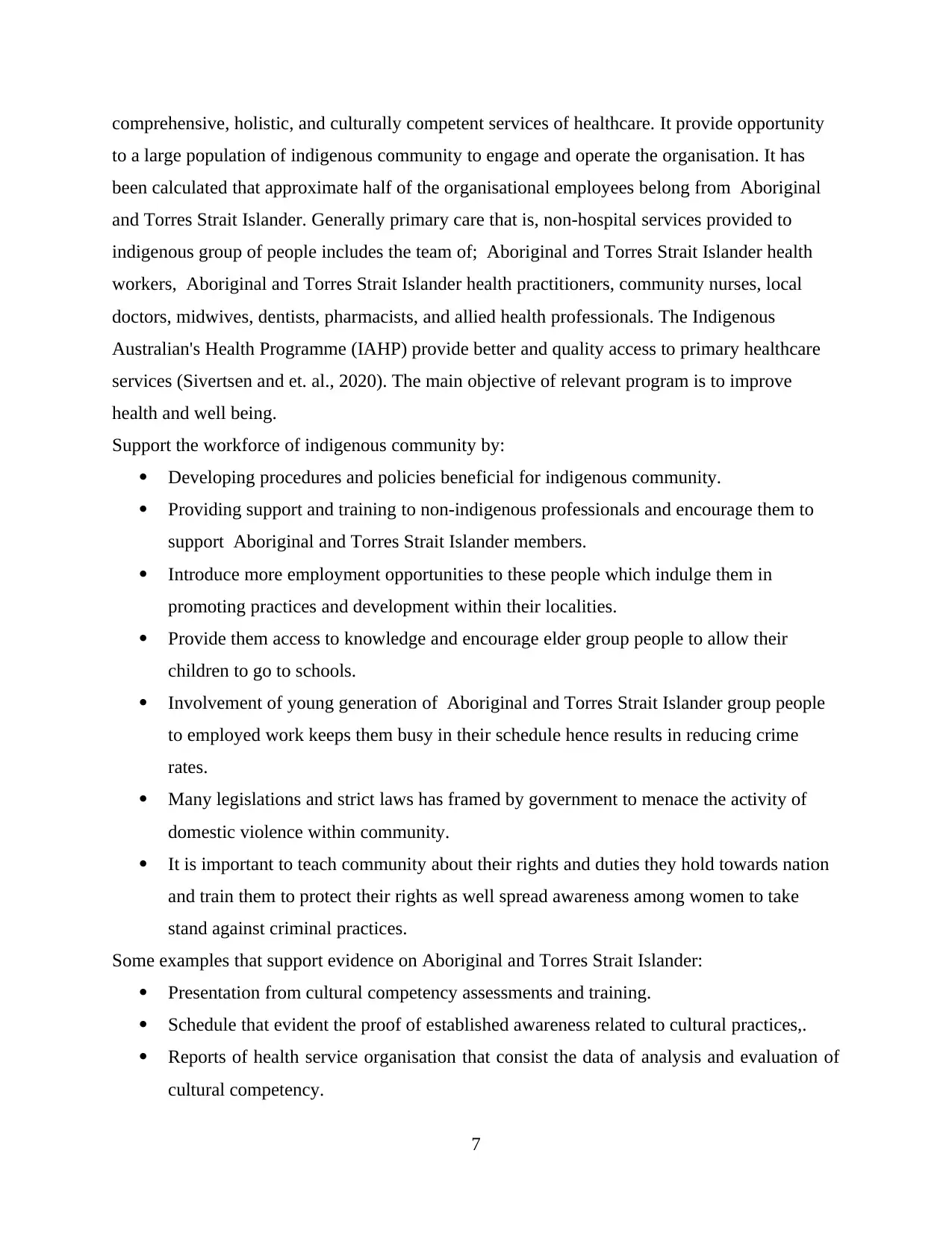
comprehensive, holistic, and culturally competent services of healthcare. It provide opportunity
to a large population of indigenous community to engage and operate the organisation. It has
been calculated that approximate half of the organisational employees belong from Aboriginal
and Torres Strait Islander. Generally primary care that is, non-hospital services provided to
indigenous group of people includes the team of; Aboriginal and Torres Strait Islander health
workers, Aboriginal and Torres Strait Islander health practitioners, community nurses, local
doctors, midwives, dentists, pharmacists, and allied health professionals. The Indigenous
Australian's Health Programme (IAHP) provide better and quality access to primary healthcare
services (Sivertsen and et. al., 2020). The main objective of relevant program is to improve
health and well being.
Support the workforce of indigenous community by:
Developing procedures and policies beneficial for indigenous community.
Providing support and training to non-indigenous professionals and encourage them to
support Aboriginal and Torres Strait Islander members.
Introduce more employment opportunities to these people which indulge them in
promoting practices and development within their localities.
Provide them access to knowledge and encourage elder group people to allow their
children to go to schools.
Involvement of young generation of Aboriginal and Torres Strait Islander group people
to employed work keeps them busy in their schedule hence results in reducing crime
rates.
Many legislations and strict laws has framed by government to menace the activity of
domestic violence within community.
It is important to teach community about their rights and duties they hold towards nation
and train them to protect their rights as well spread awareness among women to take
stand against criminal practices.
Some examples that support evidence on Aboriginal and Torres Strait Islander:
Presentation from cultural competency assessments and training.
Schedule that evident the proof of established awareness related to cultural practices,.
Reports of health service organisation that consist the data of analysis and evaluation of
cultural competency.
7
to a large population of indigenous community to engage and operate the organisation. It has
been calculated that approximate half of the organisational employees belong from Aboriginal
and Torres Strait Islander. Generally primary care that is, non-hospital services provided to
indigenous group of people includes the team of; Aboriginal and Torres Strait Islander health
workers, Aboriginal and Torres Strait Islander health practitioners, community nurses, local
doctors, midwives, dentists, pharmacists, and allied health professionals. The Indigenous
Australian's Health Programme (IAHP) provide better and quality access to primary healthcare
services (Sivertsen and et. al., 2020). The main objective of relevant program is to improve
health and well being.
Support the workforce of indigenous community by:
Developing procedures and policies beneficial for indigenous community.
Providing support and training to non-indigenous professionals and encourage them to
support Aboriginal and Torres Strait Islander members.
Introduce more employment opportunities to these people which indulge them in
promoting practices and development within their localities.
Provide them access to knowledge and encourage elder group people to allow their
children to go to schools.
Involvement of young generation of Aboriginal and Torres Strait Islander group people
to employed work keeps them busy in their schedule hence results in reducing crime
rates.
Many legislations and strict laws has framed by government to menace the activity of
domestic violence within community.
It is important to teach community about their rights and duties they hold towards nation
and train them to protect their rights as well spread awareness among women to take
stand against criminal practices.
Some examples that support evidence on Aboriginal and Torres Strait Islander:
Presentation from cultural competency assessments and training.
Schedule that evident the proof of established awareness related to cultural practices,.
Reports of health service organisation that consist the data of analysis and evaluation of
cultural competency.
7
⊘ This is a preview!⊘
Do you want full access?
Subscribe today to unlock all pages.

Trusted by 1+ million students worldwide
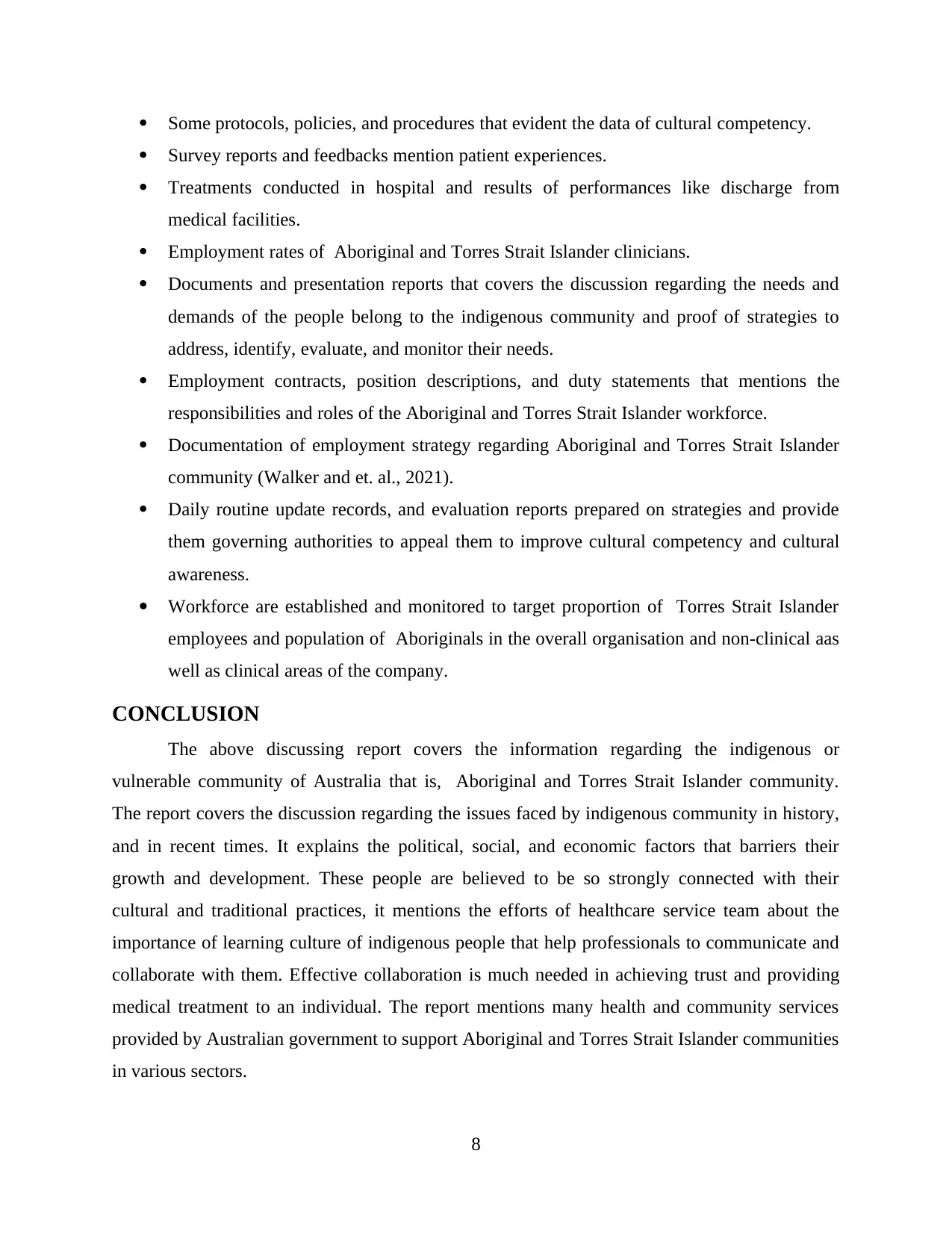
Some protocols, policies, and procedures that evident the data of cultural competency.
Survey reports and feedbacks mention patient experiences.
Treatments conducted in hospital and results of performances like discharge from
medical facilities.
Employment rates of Aboriginal and Torres Strait Islander clinicians.
Documents and presentation reports that covers the discussion regarding the needs and
demands of the people belong to the indigenous community and proof of strategies to
address, identify, evaluate, and monitor their needs.
Employment contracts, position descriptions, and duty statements that mentions the
responsibilities and roles of the Aboriginal and Torres Strait Islander workforce.
Documentation of employment strategy regarding Aboriginal and Torres Strait Islander
community (Walker and et. al., 2021).
Daily routine update records, and evaluation reports prepared on strategies and provide
them governing authorities to appeal them to improve cultural competency and cultural
awareness.
Workforce are established and monitored to target proportion of Torres Strait Islander
employees and population of Aboriginals in the overall organisation and non-clinical aas
well as clinical areas of the company.
CONCLUSION
The above discussing report covers the information regarding the indigenous or
vulnerable community of Australia that is, Aboriginal and Torres Strait Islander community.
The report covers the discussion regarding the issues faced by indigenous community in history,
and in recent times. It explains the political, social, and economic factors that barriers their
growth and development. These people are believed to be so strongly connected with their
cultural and traditional practices, it mentions the efforts of healthcare service team about the
importance of learning culture of indigenous people that help professionals to communicate and
collaborate with them. Effective collaboration is much needed in achieving trust and providing
medical treatment to an individual. The report mentions many health and community services
provided by Australian government to support Aboriginal and Torres Strait Islander communities
in various sectors.
8
Survey reports and feedbacks mention patient experiences.
Treatments conducted in hospital and results of performances like discharge from
medical facilities.
Employment rates of Aboriginal and Torres Strait Islander clinicians.
Documents and presentation reports that covers the discussion regarding the needs and
demands of the people belong to the indigenous community and proof of strategies to
address, identify, evaluate, and monitor their needs.
Employment contracts, position descriptions, and duty statements that mentions the
responsibilities and roles of the Aboriginal and Torres Strait Islander workforce.
Documentation of employment strategy regarding Aboriginal and Torres Strait Islander
community (Walker and et. al., 2021).
Daily routine update records, and evaluation reports prepared on strategies and provide
them governing authorities to appeal them to improve cultural competency and cultural
awareness.
Workforce are established and monitored to target proportion of Torres Strait Islander
employees and population of Aboriginals in the overall organisation and non-clinical aas
well as clinical areas of the company.
CONCLUSION
The above discussing report covers the information regarding the indigenous or
vulnerable community of Australia that is, Aboriginal and Torres Strait Islander community.
The report covers the discussion regarding the issues faced by indigenous community in history,
and in recent times. It explains the political, social, and economic factors that barriers their
growth and development. These people are believed to be so strongly connected with their
cultural and traditional practices, it mentions the efforts of healthcare service team about the
importance of learning culture of indigenous people that help professionals to communicate and
collaborate with them. Effective collaboration is much needed in achieving trust and providing
medical treatment to an individual. The report mentions many health and community services
provided by Australian government to support Aboriginal and Torres Strait Islander communities
in various sectors.
8
Paraphrase This Document
Need a fresh take? Get an instant paraphrase of this document with our AI Paraphraser
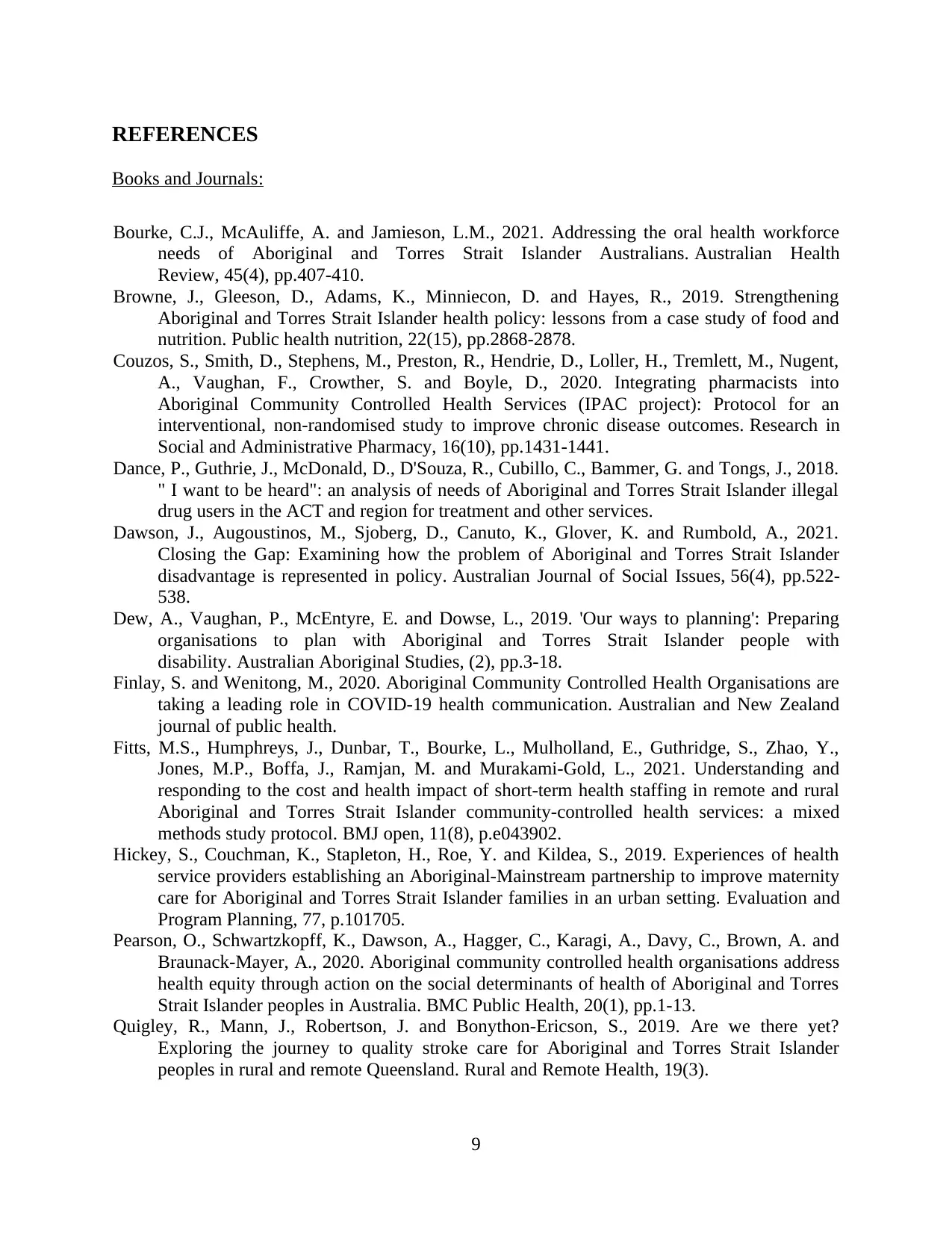
REFERENCES
Books and Journals:
Bourke, C.J., McAuliffe, A. and Jamieson, L.M., 2021. Addressing the oral health workforce
needs of Aboriginal and Torres Strait Islander Australians. Australian Health
Review, 45(4), pp.407-410.
Browne, J., Gleeson, D., Adams, K., Minniecon, D. and Hayes, R., 2019. Strengthening
Aboriginal and Torres Strait Islander health policy: lessons from a case study of food and
nutrition. Public health nutrition, 22(15), pp.2868-2878.
Couzos, S., Smith, D., Stephens, M., Preston, R., Hendrie, D., Loller, H., Tremlett, M., Nugent,
A., Vaughan, F., Crowther, S. and Boyle, D., 2020. Integrating pharmacists into
Aboriginal Community Controlled Health Services (IPAC project): Protocol for an
interventional, non-randomised study to improve chronic disease outcomes. Research in
Social and Administrative Pharmacy, 16(10), pp.1431-1441.
Dance, P., Guthrie, J., McDonald, D., D'Souza, R., Cubillo, C., Bammer, G. and Tongs, J., 2018.
" I want to be heard": an analysis of needs of Aboriginal and Torres Strait Islander illegal
drug users in the ACT and region for treatment and other services.
Dawson, J., Augoustinos, M., Sjoberg, D., Canuto, K., Glover, K. and Rumbold, A., 2021.
Closing the Gap: Examining how the problem of Aboriginal and Torres Strait Islander
disadvantage is represented in policy. Australian Journal of Social Issues, 56(4), pp.522-
538.
Dew, A., Vaughan, P., McEntyre, E. and Dowse, L., 2019. 'Our ways to planning': Preparing
organisations to plan with Aboriginal and Torres Strait Islander people with
disability. Australian Aboriginal Studies, (2), pp.3-18.
Finlay, S. and Wenitong, M., 2020. Aboriginal Community Controlled Health Organisations are
taking a leading role in COVID‐19 health communication. Australian and New Zealand
journal of public health.
Fitts, M.S., Humphreys, J., Dunbar, T., Bourke, L., Mulholland, E., Guthridge, S., Zhao, Y.,
Jones, M.P., Boffa, J., Ramjan, M. and Murakami-Gold, L., 2021. Understanding and
responding to the cost and health impact of short-term health staffing in remote and rural
Aboriginal and Torres Strait Islander community-controlled health services: a mixed
methods study protocol. BMJ open, 11(8), p.e043902.
Hickey, S., Couchman, K., Stapleton, H., Roe, Y. and Kildea, S., 2019. Experiences of health
service providers establishing an Aboriginal-Mainstream partnership to improve maternity
care for Aboriginal and Torres Strait Islander families in an urban setting. Evaluation and
Program Planning, 77, p.101705.
Pearson, O., Schwartzkopff, K., Dawson, A., Hagger, C., Karagi, A., Davy, C., Brown, A. and
Braunack-Mayer, A., 2020. Aboriginal community controlled health organisations address
health equity through action on the social determinants of health of Aboriginal and Torres
Strait Islander peoples in Australia. BMC Public Health, 20(1), pp.1-13.
Quigley, R., Mann, J., Robertson, J. and Bonython-Ericson, S., 2019. Are we there yet?
Exploring the journey to quality stroke care for Aboriginal and Torres Strait Islander
peoples in rural and remote Queensland. Rural and Remote Health, 19(3).
9
Books and Journals:
Bourke, C.J., McAuliffe, A. and Jamieson, L.M., 2021. Addressing the oral health workforce
needs of Aboriginal and Torres Strait Islander Australians. Australian Health
Review, 45(4), pp.407-410.
Browne, J., Gleeson, D., Adams, K., Minniecon, D. and Hayes, R., 2019. Strengthening
Aboriginal and Torres Strait Islander health policy: lessons from a case study of food and
nutrition. Public health nutrition, 22(15), pp.2868-2878.
Couzos, S., Smith, D., Stephens, M., Preston, R., Hendrie, D., Loller, H., Tremlett, M., Nugent,
A., Vaughan, F., Crowther, S. and Boyle, D., 2020. Integrating pharmacists into
Aboriginal Community Controlled Health Services (IPAC project): Protocol for an
interventional, non-randomised study to improve chronic disease outcomes. Research in
Social and Administrative Pharmacy, 16(10), pp.1431-1441.
Dance, P., Guthrie, J., McDonald, D., D'Souza, R., Cubillo, C., Bammer, G. and Tongs, J., 2018.
" I want to be heard": an analysis of needs of Aboriginal and Torres Strait Islander illegal
drug users in the ACT and region for treatment and other services.
Dawson, J., Augoustinos, M., Sjoberg, D., Canuto, K., Glover, K. and Rumbold, A., 2021.
Closing the Gap: Examining how the problem of Aboriginal and Torres Strait Islander
disadvantage is represented in policy. Australian Journal of Social Issues, 56(4), pp.522-
538.
Dew, A., Vaughan, P., McEntyre, E. and Dowse, L., 2019. 'Our ways to planning': Preparing
organisations to plan with Aboriginal and Torres Strait Islander people with
disability. Australian Aboriginal Studies, (2), pp.3-18.
Finlay, S. and Wenitong, M., 2020. Aboriginal Community Controlled Health Organisations are
taking a leading role in COVID‐19 health communication. Australian and New Zealand
journal of public health.
Fitts, M.S., Humphreys, J., Dunbar, T., Bourke, L., Mulholland, E., Guthridge, S., Zhao, Y.,
Jones, M.P., Boffa, J., Ramjan, M. and Murakami-Gold, L., 2021. Understanding and
responding to the cost and health impact of short-term health staffing in remote and rural
Aboriginal and Torres Strait Islander community-controlled health services: a mixed
methods study protocol. BMJ open, 11(8), p.e043902.
Hickey, S., Couchman, K., Stapleton, H., Roe, Y. and Kildea, S., 2019. Experiences of health
service providers establishing an Aboriginal-Mainstream partnership to improve maternity
care for Aboriginal and Torres Strait Islander families in an urban setting. Evaluation and
Program Planning, 77, p.101705.
Pearson, O., Schwartzkopff, K., Dawson, A., Hagger, C., Karagi, A., Davy, C., Brown, A. and
Braunack-Mayer, A., 2020. Aboriginal community controlled health organisations address
health equity through action on the social determinants of health of Aboriginal and Torres
Strait Islander peoples in Australia. BMC Public Health, 20(1), pp.1-13.
Quigley, R., Mann, J., Robertson, J. and Bonython-Ericson, S., 2019. Are we there yet?
Exploring the journey to quality stroke care for Aboriginal and Torres Strait Islander
peoples in rural and remote Queensland. Rural and Remote Health, 19(3).
9

Shmerling, E., Creati, M., Belfrage, M. and Hedges, S., 2020. The health needs of Aboriginal
and Torres Strait Islander children in out‐of‐home care. Journal of Paediatrics and Child
Health, 56(3), pp.384-388.
Sivertsen, N., Anikeeva, O., Deverix, J. and Grant, J., 2020. Aboriginal and Torres Strait
Islander family access to continuity of health care services in the first 1000 days of life: a
systematic review of the literature. BMC health services research, 20(1), pp.1-9.
Walker, N., Mackean, T., Longbottom, M., Coombes, J., Bennett‐Brook, K., Clapham, K., Ivers,
R., Hackett, M., Redfern, J. and Cullen, P., 2021. Responses to the primary health care
needs of Aboriginal and Torres Strait Islander women experiencing violence: A scoping
review of policy and practice guidelines. Health promotion journal of Australia, 32, pp.40-
53.
10
and Torres Strait Islander children in out‐of‐home care. Journal of Paediatrics and Child
Health, 56(3), pp.384-388.
Sivertsen, N., Anikeeva, O., Deverix, J. and Grant, J., 2020. Aboriginal and Torres Strait
Islander family access to continuity of health care services in the first 1000 days of life: a
systematic review of the literature. BMC health services research, 20(1), pp.1-9.
Walker, N., Mackean, T., Longbottom, M., Coombes, J., Bennett‐Brook, K., Clapham, K., Ivers,
R., Hackett, M., Redfern, J. and Cullen, P., 2021. Responses to the primary health care
needs of Aboriginal and Torres Strait Islander women experiencing violence: A scoping
review of policy and practice guidelines. Health promotion journal of Australia, 32, pp.40-
53.
10
⊘ This is a preview!⊘
Do you want full access?
Subscribe today to unlock all pages.

Trusted by 1+ million students worldwide
1 out of 12
Related Documents
Your All-in-One AI-Powered Toolkit for Academic Success.
+13062052269
info@desklib.com
Available 24*7 on WhatsApp / Email
![[object Object]](/_next/static/media/star-bottom.7253800d.svg)
Unlock your academic potential
Copyright © 2020–2025 A2Z Services. All Rights Reserved. Developed and managed by ZUCOL.





